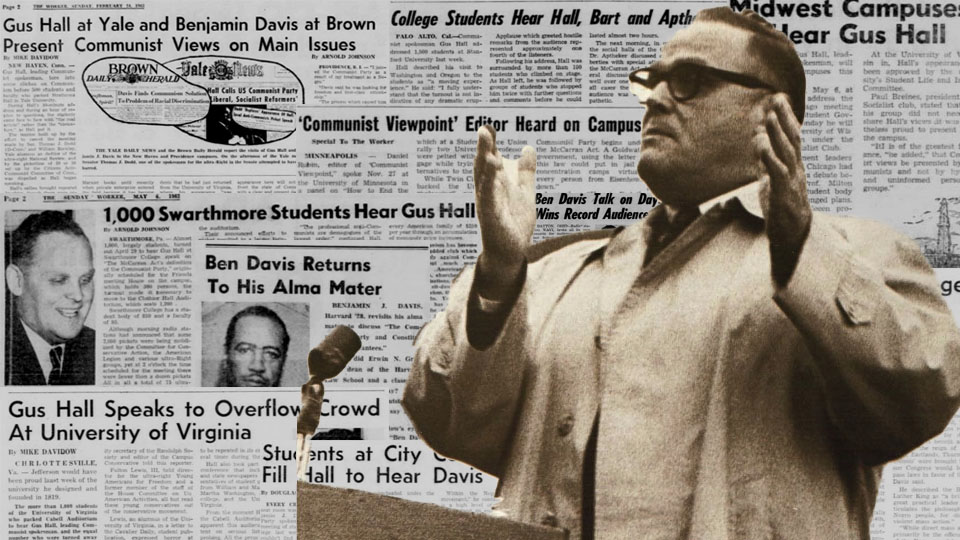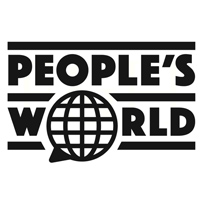
The following is a preview of a new book just released by International Publishers:
Faith in the Masses: Essays Celebrating 100 years of the Communist Party USA
The book features contributions from more than a dozen authors examining various episodes, personalities, and themes from across the CPUSA’s century of existence. Edited by Tony Pecinovsky, Faith in the Masses challenges anti-communist narratives as well as “orthodox” historians who’ve attempted to portray the CPUSA as an appendage of the Soviet Union rather than a product of domestic struggles in the United States for economic, racial, gender, and social equality.
This excerpt comes from a chapter written by Pecinovsky entitled, “Far From Marginal: The CPUSA in the 1960s and early 1970s.”
1962: “The tide has turned…”
It was February 12, 1962. Communist Party USA general secretary Gus Hall was in the midst of a West Coast speaking tour. On this particular evening, police on horseback nervously observed in the backfield while cheerleaders ushered attendees to their seats as more than 12,000 students packed the University of Oregon football field. Later that night, Hall spoke to an additional 3,000 students at Oregon College in Monmouth. On February 13, he spoke with 1,000 students at Lewis and Clark College and then on the 14th to “only 800” at Reed College, as Portland officials refused to let Hall speak at the city auditorium, which could have accommodated the additional 1,000 students who “stood around trying to get in.”
Order from International Publishers
According to Philip Bart, onetime chair of the CPUSA’s history commission, Hall spoke in front of a cumulative 19,000 students on five campuses between February 10th and 15th, 1962, including the University of California, where “a spontaneously organized gathering of hundreds” met with Hall after he concluded his remarks. Hall told students, “Anti-communism is just a smoke-screen, the real aim is to destroy the Bill of Rights.” This was a sentiment supported by over a decade of ramified political repression directed at the CPUSA and the broader movements for social and economic justice; the result was a constraining of domestic political discourse.
Just days later, Hall spoke at Stanford University in front of 1,500 students, while his comrade Arnold Johnson jammed the 700-person capacity auditorium at Hamilton College. According to the Utica Daily Press, “There were people sitting in the organ loft and on stairs, the floor, and window ledges” to hear the party stalwart. Also in February, 350 students heard Bart at Bowdoin College in Maine, and hundreds more heard Marxist historian Herbert Aptheker in St. Paul, Minnesota. Aptheker also addressed 250 students at the University of Pennsylvania in early April, while the onetime Communist Councilman from Harlem, Benjamin Davis, Jr., addressed 600 students at Harvard. And African-American party leader James E. Jackson, editor of The Worker, spoke with 1,400 students at Colby College in May.
It was reported in early March 1962 that Hall gave 37 separate speeches in just 12 days. In April, he told 400 students at City College-New York that if the McCarran Act prosecutors succeed in jailing him and Benjamin Davis, Jr., “no American…will be free.” Unlike the political inquisitors, his sights were centered on domestic civil liberties. This was a recurring theme for the steelworker turned union organizer turned Communist. Fortunately for Hall and his comrades, the political winds were shifting. Later that month, nearly 1,000 students turned out at Swarthmore College to hear Hall. On May 1, he addressed 7,000 people at the Union Square May Day rally. Days later, he spoke with 400 students at Hunter College, 700 students at the University of Chicago, and 1,800 more at the University of Wisconsin, where another 1,500 students were turned away due to a lack of seating.
By mid-June 1962, Hall declared, “During the past six months, I have spoken to some 50,000 students and youth directly…The tide has turned.” Communist speaking engagements continued into the fall. For example, in late November, Michigan party leader Carl Winter spoke with 900 students at Kalamazoo College, a campus traditionally thought of as a conservative stronghold. Communists had every reason to believe it was time to go on the offensive.
That spring, Hall noted, “In the mass movements, the most important and most active contingent are the youth.” Jubilantly, he added, the “student demand” to hear Communists was “completely without precedent.” It was of such magnitude, he said, “that no force is able to ignore it,” including the FBI. “It has become a point of discussion on all levels of political life,” he continued. “We are so close to it that we do not fully appreciate it.” This is an important point, as many today seem unable to fully appreciate it as well. Hall called the growing demand for Communist speakers “a mass break-out from the conformist strait-jacket of McCarthyism” and a “rejection of anti-Communism,” a bewildering defeat for the ruling class.
Though many of the emerging student groups were “loose and even temporary in nature,” Hall was optimistic. He saw the potential for a “spark that can fundamentally change” and challenge the contours of U.S. anti-communism, a spark spearheaded by youth. Additionally, he noted the array of self-published journals students were then printing. “Isn’t it fantastic that in a number of colleges, there are two, three, or four monthly magazines and newspapers,” Hall continued, many with a Marxist outlook. That Communists “must be a factor in finding forms through which this tremendous energy can best express itself,” was a given for Hall. That “We must not be mere observers,” was another.
Hall’s perspective, that Communists “must be a force in helping to initiate forms of united action in this upsurge and help give it cohesion and direction,” wasn’t rhetorical. Party-led youth formations like the Advance Youth Organization, the publication New Horizons for Youth, the Progressive Youth Organizing Committee, and later the W.E.B. DuBois Clubs were emerging. In this regard, Hall viewed the string of Communist speaking engagements in the early 1960s as not just “victories for free speech and democratic rights, won in the face of a powerful campaign organized by the ultra-right,” a campaign that was being defiantly challenged by youth and students. He also saw these engagements as an opportunity to introduce students to Marxism-Leninism and rebuild the CPUSA.
The substance of Hall’s campus presentations often focused on free speech, democracy, the defeat of the ultra-right, and peace. Speaking to students in New York, Hall hailed freedom of speech as vital. “It’s a weapon,” he added. It must be preserved if we hope to collectively “thrash out the very complicated problems [youth] face.” He connected the fight for free speech generally to the fight to hear Communists specifically. “There is a very deep feeling that if you can preserve the right of Communists to speak, then you can preserve the right of all to speak. That’s true. But it’s more than just a fight for the right of Communists to speak. The fact is that they [youth and students] want to hear a Communist speak…They are sick and tired of hearing the so-called Communist viewpoint from anti-Communists.”
To Hall, a shift in consciousness was taking place. The “fascist-like assault” designed to “transform the American people into a hysterical anti-Communist mob” had failed. Senator Joseph McCarthy had been silenced. The Smith and McCarran Acts would both be declared unconstitutional. Communists were now on the offensive, regularly speaking to thousands of students across the country. The “squirming of politicians,” the “fanatical fascist-like fringe of the ultra-right” was being “pushed back into its lair,” Hall concluded. This was partly due to the courage of student activists who spearheaded the right of Communists to speak on college and university campuses across the country, a strategic relationship Hall would not soon forget and one that would become a prominent feature of the general secretary’s work for many years to come.

As noted above, J. Edgar Hoover’s FBI unsurprisingly took note of this shift, too. They saw the tide turning as well. Cartha D. De Loach, assistant director of the FBI, speaking at an American Bar Association conference in January 1962, told reporters, “the Communists have grown increasingly ambitious in their designs upon youth.” He noted that the Communist-led Progressive Youth Organizing Committee, which was founded on December 30, 1960 to January 2, 1961, was created “to pave the way for greater Communist influence” among “broad segments of our college students.” De Loach also credited Hall with the party’s “renewed emphasis on youth.”
Communists and their successful speaking engagements were getting under Hoover’s skin. Uniformed and undercover police watched Hall’s every move. For example, it was reported in the New York Times that 22 uniformed police and 15 detectives attended Hall’s early May Hunter College speaking engagement. That same month, Time magazine reported that “some 100 campuses” had extended invitations to Communist speakers. It did not, however, report on the number of colleges and universities that had denied Hall, and other Communists, their First Amendment right—which was likely also a considerable number.
In September 1962, the party’s Lecture and Information Bureau sent a series of letters to various professors, college papers, student councils, and organizations requesting that “you invite representatives of the Communist Party to speak.” This was a deliberate, systematic approach to reach students. In “the past year Communist spokesmen addressed more than thirty colleges and universities” where “approximately 75,000 students and townspeople” attended. “It is clear from this,” the letter concluded, “that students wish to hear the Communist viewpoint from bona fide spokesmen. Students in their search for knowledge apparently are not satisfied to learn about communism from anti-Communists.” Those hoping to stunt the youth and student movement and its welcoming of Communists were likely dismayed.
After over a decade of political repression, Communists seemed poised to make a comeback.











